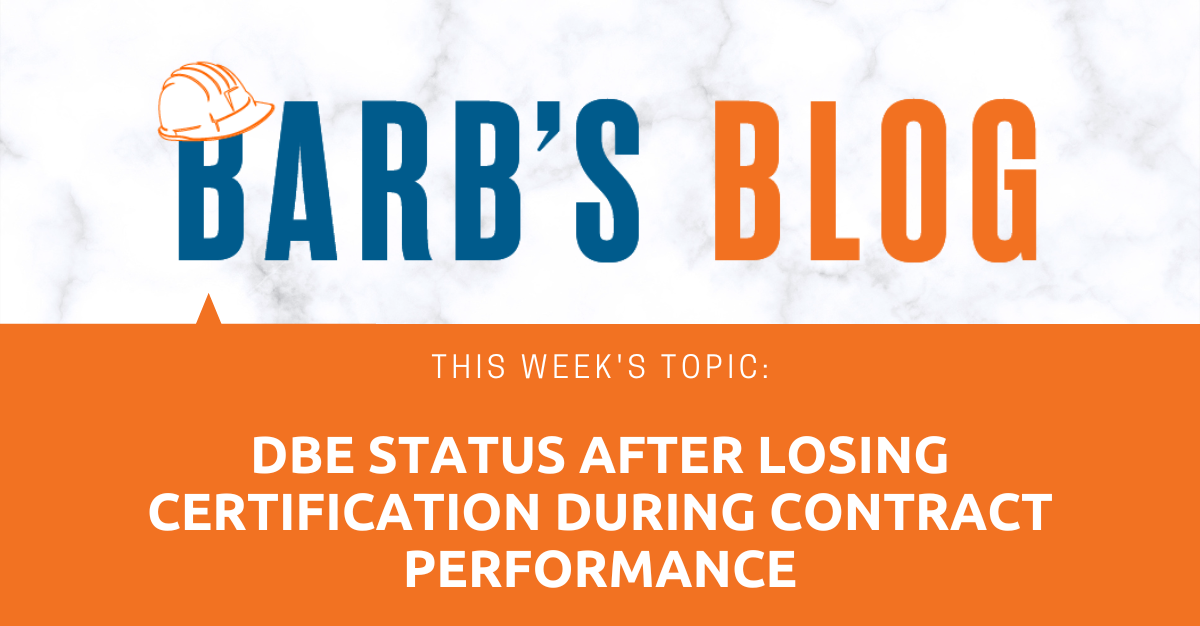
This is part 3 of the DBE Final Rule Change Blog Series.
Part 1: “DBE Procedural Changes for Certification.”
Part 2: “DBE Supplier Definitions & Counting“.
DBE Final Rule Blog Series:
The Department of Transportation proposed new rules to the Disadvantaged Business Enterprise (DBE) program with public listening and comment period in 2022. The intent of the new rules was to modernize and improve the program, reduce burdens to firms, grow capacity and owner wealth and improve integrity and data for the program. The final rule changes went into effect May 9, 2024. All new rules are in effect as of May 9, 2024. Any decisions on applications after that date must use the new rules. I have been participating in training for the changes and in this series, I will break down the changes for you all in the different areas.
DBE Status After Losing Certification During Contract Performance
I have worked with a few companies over the past three years that sold their businesses. How to count contract participation has been a piece of the ownership transition puzzle that often needs to be addressed. Under the new DBE rules there have been a few changes that I am sharing with you today.
It is important to understand that there are two measures of counting participation to goals. First is a DBE goal that DOT fund assisted recipients (think MnDOT, MAC, etc.) need to report on – recipient’s overall reporting goal. The one you are most familiar with is the individual subcontracting goals set on specific project – Prime Contractor needs to Subcontract X% of the project contract value to DBEs or make a good faith effort (GFE) to do so.
This blog post of the DBE Rules series is on how to count participation after a business is decertified through any means, not just ownership change, but also an entity deeming the business no longer qualifies as a DBE. I am including some unchanged counting clarifications for you that you might find helpful.
Rules that have not had a change:
- When a DBE is awarded a prime contract and is decertified before the contract is executed, the DBE will not count toward the recipient’s overall reporting goal.
- When a DBE is awarded a prime contract and is decertified after the contract is executed. The portion of the contract remaining after decertification WOULD count toward any contract goals but does not count towards the recipient’s overall reporting goal.
- When a DBE is a subcontractor and is decertified prior to the contract being executed, the prime contractor can NOT count that DBE’s subcontract towards the contract goal. The prime contractor must replace the DBE participation percentage with a certified DBE or show good faith effort (GFE) of trying to replace the participation.
- When a DBE is a subcontractor and becomes decertified after the contract is executed, the prime contractor CAN continue to count the participation of the decertified subcontractor toward the contract goal for the original contract amount. Participation will not count toward the recipient’s overall goal, however.
- If a DBE is decertified solely because it exceeds the size standard during the performance of the contract, the participation CAN continue to count in both the subcontracting goal and the recipient’s overall reporting goal.
Rules with a slight change:
- When a DBE is a subcontractor and becomes decertified after the contract is executed, the prime contractor can continue to count the participation of the decertified subcontractor toward the contract goal for the original contract amount. If a Prime Contractor wants to add work to the subcontractor, they MUST have written consent from the recipient to count additional participation.
Rules that have changed:
- If a DBE is acquired by or merges with a non-DBE firm or is purchased by new owners that do not qualify as disadvantaged, the DBE becomes decertified. The prime contractor can NOT count the participation of the decertified subcontractor, from the time they are decertified, toward the contracting goal. The prime contractor must subcontract additional dollars to eligible DBE subcontractor(s) or demonstrate good faith efforts to do so. This does not require termination of the decertified firm, but the prime contractor must find additional subcontracting opportunities or additional work to current DBEs on the project. The participation also will not count toward the recipient’s overall goal.
While not too much has changed, it is a great overview and should be an easy-to-understand resource for decertification issues as they arise. That said, nonfederal municipalities look at this differently. With one member who was purchased by a non-DBE and working for multiple public entities we had a very difficult time tracking down the different rules. Make sure you check the rules for the entity you are working under contract with.
— B
